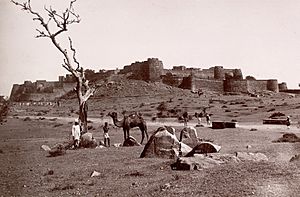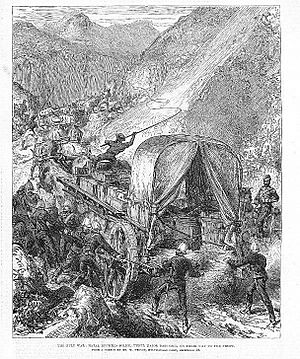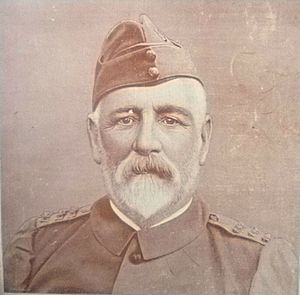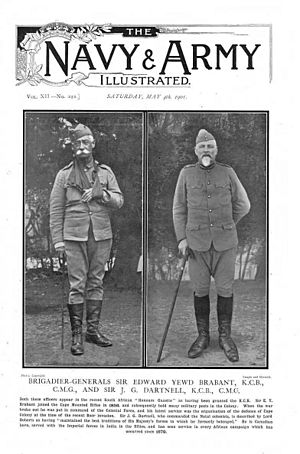John Dartnell facts for kids
Sir John George Dartnell (born April 2, 1838 – died August 7, 1913) was a British soldier and police officer. He is famous for starting and leading the Natal Mounted Police in South Africa. Dartnell was a veteran of the Indian Rebellion. He fought in many important conflicts in South Africa from 1879. These included the Zulu War and both the First and Second Boer Wars.
Contents
Early Life
John Dartnell was born in Ontario, Canada, in 1838. He was one of seven children. His father, George Russell Dartnell, was a doctor in the British Army. By 1851, his family lived in Rochester, England.
Indian Rebellion (1857–1859)
Dartnell joined the 86th Regiment of Foot as an Ensign in 1855. He was promoted to Lieutenant in 1856. During the Indian Rebellion (1857–1859), he served with his regiment. He fought bravely during the attack on Chanderi in March 1858. He was also at the attack on Jhansi Fort on April 3, 1858.
During the attack on Jhansi Fort, Dartnell was severely wounded. He was the first soldier to climb a ladder to the fort wall. Mutineers attacked him with swords and shot him. He was suggested for the Victoria Cross, a very high award for bravery. However, he did not receive it. For his courage, he was promoted to company commander. He returned to Britain to heal from his injuries. In 1859, he became a Captain. He then joined the 16th (Bedfordshire) Regiment of Foot.
In 1862, Dartnell moved to the 27th (Inniskilling) Regiment of Foot. With this regiment, he fought in the Bhutan War in 1865. He was also an assistant (Aide-de-camp) to Major General Sir Henry Tombs. He was present when Dewangiri was captured. For his service in India, he received the Indian Mutiny Medal.
Moving to Natal
In 1865, while in India, Dartnell married Clara Alicia Steer. They had six children together. In 1869, he left the Army. He and his family moved to Natal in South Africa. His younger children were born there.
Dartnell tried farming, but his wife soon grew tired of the quiet life. She encouraged him to find a different way to earn a living.
Founding the Natal Mounted Police
In 1874, the Governor of Natal decided to create a mounted police force. This happened after a rebellion by Chief Langalibalele. Dartnell decided to apply for the leader position. He had no police experience. However, he was an experienced army officer. He was offered and accepted the role of Commandant.
Dartnell was promoted to Major. He wanted to learn how to lead a police force. So, he went to Cape Colony to study the Frontier Armed and Mounted Police. When he returned to Natal, he began forming the Natal Mounted Police. He first wanted to recruit men from Great Britain. But he was told to recruit local men. The first person to join was Edward Babington in 1874.
Dartnell later described his recruits. He said they were a "rough lot" but "very fine, hardy men." He noted they were "ready to go anywhere and do anything." They were also "very willing and cheerful."
Zulu War (1879)
In 1879, during the Zulu War, the Natal Mounted Police joined the British Army. They were part of the Central Column led by Lord Chelmsford. The NMP formed part of the mounted group. Dartnell himself joined Chelmsford's staff.
The NMP men were not happy about not being led by Dartnell in the field. They refused to cross into Zululand unless he was put back in command. They even threatened to quit. Dartnell was a strict soldier. He talked strongly with his men and convinced them to serve under Major Russell.
On January 21, 1879, Dartnell led 97 NMP men to find the Zulu army of Cetshwayo kaMpande. They rode towards Hlazakazi Hill, about 10 miles from Isandlwana. Dartnell's force met some Zulu warriors. He then saw a very large Zulu force. He knew his men were not enough to fight them. So, he decided to watch them from a safe distance.
He sent two troopers back to Isandlwana to report to Lord Chelmsford. He told Chelmsford about the large Zulu force. He also said he and his men would stay at Hlazakazi Hill overnight to keep watching. Chelmsford sent a message back, saying Dartnell could fight the enemy if he thought it was right. However, by the time Dartnell got this message, the Zulu force had grown to thousands of warriors.
Late on January 21, Dartnell sent another messenger to Chelmsford at Isandlwana. He reported the huge Zulu force and asked for help. Chelmsford received the message at 1:30 AM on January 22. He decided Dartnell had found the main Zulu force. At dawn, he led a large force to help. This force included soldiers from the 24th Regiment of Foot, mounted infantry, and four artillery guns.
When Chelmsford reached Dartnell, the Zulus were gone. They had simply gone around the British force. They were heading for Isandlwana.
The second group of 34 NMP men Dartnell had left behind fought in the Battle of Isandlwana on January 22, 1879. Twenty-five of these men were killed. Twenty-one of them died fighting bravely with 19 Natal Carbineers. They were defending Lieutenant-Colonel Anthony Durnford. Three NMP men escaped Isandlwana. They made it to Rorke's Drift and fought in the Battle of Rorke's Drift. One of them, Sidney Hunter, was killed there.
Dartnell's first group of NMP returned to Isandlwana on the evening of the battle. They spent the night among the camp's ruins and the bodies of their friends. The next morning, they joined Lord Chelmsford's relief column. They advanced to Rorke's Drift.
Other Rebellions
Under Dartnell, the Natal Mounted Police also served in the Basuto Gun War (1880–1881). They defended mountain passes from attacks by the Basuto. They also served in the Transvaal Rebellion (1880–1881). Here, the NMP formed a mounted military force on the border with the Transvaal.
After these rebellions, normal police duties started again. NMP men provided an escort for Empress Eugénie in 1880. She came to Natal to see where her son, Napoléon, had been killed. He died the year before during the Zulu War.
Dartnell was in charge of the Volunteer Forces in Natal. He was promoted to Colonel in 1885. In 1887, he became a member of the Defence Committee.
Chief Commissioner of the Natal Police
In 1894, the Natal Mounted Police joined with other police and prison services in Natal. This created the Natal Police (NP). This new force lasted until 1913. Even though the NMP had mostly been a military unit, Dartnell was promoted to Colonel. He was made the Chief Commissioner of the new force. He also became a Justice of the Peace (JP). He worked as Secretary for Native Affairs. He was also Commissioner of Mines and Inspector of Prisons.
As Chief Commissioner, Dartnell first increased the number of European police officers from 200 to 300. He also hired 100 more African officers. He set up 11 police districts. He increased the number of small police stations from 26 to 60. In 1894, under the new force, the number of arrests went from 2,564 to 16,568. Dartnell's Natal Police was so good that other police forces in South Africa used his organization as a model. In 1898, the Zululand Native Police joined the Natal Police. Ten new police stations were set up in Zululand.
The Natal Police were the first in Africa to use fingerprinting for solving crimes. Sub-Inspector W. J. Clarke of the Natal Police's Criminal Investigation Department (CID) started this. He was impressed by how well fingerprinting worked in Calcutta in 1897. He brought the system to Natal in 1898, paying for it himself. Once it proved useful by leading to more arrests, fingerprinting became a normal police method in Natal. The system was so effective that by 1910, the Natal Police's CID had more fingerprints on file than Scotland Yard in London. Clarke later took over from Dartnell as Chief Commissioner when Dartnell retired in 1903.
Boer War (1899–1902)
At the start of the Boer War (1899–1902), Dartnell was with Major-General Sir William Penn Symons at Dundee. The Natal Police men at Dundee fought in the Battle of Talana Hill on October 20, 1899. The British forces, including 90 men of the Natal Police under Dartnell, then went to Ladysmith. They became trapped during the Siege of Ladysmith. Dartnell, as Colonel-in-Chief of the Colonial Forces, joined General George White's staff at Ladysmith. The Natal Police men came under fire at Lombard's Kop on October 30, 1899. At Ladysmith, one Natal Police man was killed, three were wounded, and three more died from illness.
On December 7, 1899, during the Siege, the Natal Volunteers and the Imperial Light Horse launched a night attack. They attacked Gun Hill from Ladysmith. The Natal Police, led by Dartnell, protected the left side during this action. The Imperial Light Horse and Natal Carbineers, with engineers, surprised the Boers. They forced them to retreat and leave their guns. The engineers put explosives on a howitzer and a "Long Tom" cannon. They took parts from the Long Tom and a Maxim gun back to Ladysmith. The Natal Police were on the other side of a hill. They did not hear the signal to "retire" and were late returning to Ladysmith.
Dartnell and the NP saw more action on the evening of January 5, 1900. A guard post near Caesar's Camp was fired upon. This was during a major attack by the Boers on the British at Wagon Hill. Early the next morning, the Boers shot the NP's horses. This forced the police to walk back while under heavy rifle fire. After a British counterattack, the Boers withdrew.
To boost morale, Dartnell helped organize a children's Christmas party on December 25, 1899. He got four decorated Christmas trees. Presents were given to the children by "Father Christmas," who was a soldier in costume. On January 4, 1900, a Boer shell directly hit Dartnell's empty tent, destroying everything inside. The Siege of Ladysmith ended on February 28, 1900. An advance group of mounted soldiers reached Ladysmith. This group included 15 members of the Natal Police.
When the Boers started using guerrilla tactics, Dartnell was promoted to Brigadier-General. He was put in charge of the Volunteer Brigade. His job was to force the last Boers out of Natal. He served under General Sir Redvers Buller in 1900. From August 1901, he commanded the Imperial Light Horse Brigade in Orange River Colony. This brigade fought in many battles.
In April 1901, Lord Roberts, who commanded British forces in South Africa, praised Dartnell. He said Dartnell "maintained the best traditions of the regular forces." He added that Dartnell was highly respected by the colonists and had great influence over the native people. Lord Roberts noted Dartnell's advice was very helpful in the early parts of the war. He also helped during the Siege of Ladysmith and in clearing Natal of enemies. For his service during the Boer War, Dartnell received the KCB and CMG honors.
Aged 63, Brigadier-General Dartnell left command of the Imperial Light Horse Brigade on December 23, 1901. His Queen's South Africa Medal had bars for Transvaal, Talana, Defence of Ladysmith, and Laing's Nek.
Retirement
In 1903, after 30 years of service, Major-General Sir John Dartnell retired from the Natal Police. He and his wife moved to Rochester in Kent, where he had lived as a boy. Later, they moved to Folkestone in Kent. He died there in 1913 at age 76. He was buried in Cheriton Road Cemetery in Folkestone.
Medals and Honors
Major General John Dartnell received many medals for his bravery and service.






